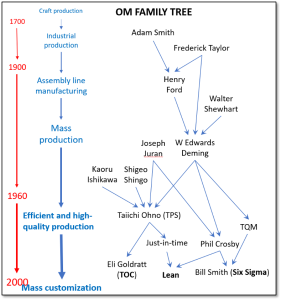Introduction
Mike Dixon and Rick Hardcopf
Management education prepares the next generation of business leaders to make effective decisions and lead successful enterprises. While the ideas that create successful organizations can be the product of innovative ‘net new’ thinking, they are more often the result of advancing past thinking and ideas. This open-source book attempts to show how current Operations Management (OM) thinking and practice came to be by summarizing the ideas of historical figures who primarily contributed to its creation. We hope this historical exposition inspires scholars and operational leaders to advance OM thinking and ideas. We also hope it helps spur an interest in OM among students by explaining the exciting history of OM and providing context to the interactions (good and bad) they have every day with various enterprises.
The field of operations management arguably began in earnest with the western ideals of capitalism and free trade. Through the accrual of profits, capitalism rewards individuals and organizations that perform, create, produce, or serve more efficiently and effectively than their competitors. OM, as a discipline, is interested in maximizing profit through the efficient and effective conversion of process inputs, such as knowledge, raw materials, and capital, into products and services. From a profit perspective, firms earn greater revenue from products and services that are produced faster and cheaper, have greater variety, and are of higher quality. Margins are also greater when products and services use less resources and have fewer defects. Free market competition ensures that organizations which deliver goods and services faster, cheaper, and better will survive and thrive, while organizations that don’t will cease to exist.
OM is a practical science, akin to medicine. Medical practitioners apply the rigors of biology, chemistry, and physiology to improve patient outcomes. OM practitioners apply principles from economics, philosophy, psychology, and sociology to develop and deliver products and services that improve firm outcomes. As a practical science, throughout history, OM has relied on practical and empirical experimentation to discover and develop enduring theories and principles. For this reason, the evolution of OM can start with a philosophical economist like Adam Smith and lead to a practical systems builder like Taiichi Ohno. Along the way, both the philosophy and practice of OM have progressed hand-in-hand.
Practically, OM is about how to do work optimally, as defined by the customer. Initial OM thinkers considered the fundamental question of who should make what and why (craft production). The questions evolved into thinking about how to effectively use machines in the creation of goods and services (industrial production), how to produce greater quantities at low cost (mass production), how to improve quality while keeping costs low (efficient and high-quality production), and eventually how to deliver variety at low cost (mass customization). As organizations and production operations grew in scale and scope, new OM practices emerged which ensured ‘survival of the fittest’, as defined by the customer.
This book is about the people who spent their professional lives thinking about these questions, developing and practically testing theories and designing operational systems that could be used to improve organizational outcomes. Along the way, they learned and borrowed from one another to create a new version of operational best practice. Current operational best practices are the result of decades of trial and error. Putting into historical context the ideas that may seem commonplace allows OM students to better grasp the significance and importance of the ‘big ideas’. The legacy behind the discovery of big ideas is often contextual, that is, knowing what influenced past OM thought leaders to think differently helps current OM students fully appreciate innovative thought. Further, understanding how innovation and insight were discovered can lead to new experiments and new discoveries.
To begin a dialogue on the history of OM and how current OM thinking came to be, we propose the following ‘OM family tree’. While Adam Smith was obviously influenced by others before him, we began there to focus more purposely on the development of current OM best practices, such as lean, six sigma, and theory of constraints.

In “The People Behind the Big Ideas of Operations Management”, we present an abridged history of OM, as told through the stories of the ‘gurus’ who discovered major theories and developed innovative new OM practices. We do so humbly, acknowledging that the chapters will forever be incomplete. As an open-source project, we invite authors with an interest and expertise in OM to expand the story by editing current chapters or submitting new chapters for consideration. Ideas and questions can be sent to the editors.
Our hope is that students of management will find these chapters helpful in developing their own philosophy of management. How will you ensure efficiency and quality of products and services? How will you organize, deploy, utilize, motivate, and appreciate the human and non-human resources under your direction? What underlying big ideas will drive your vision of excellence?
